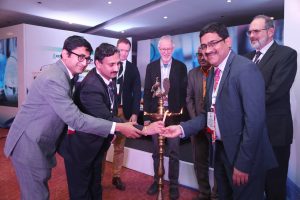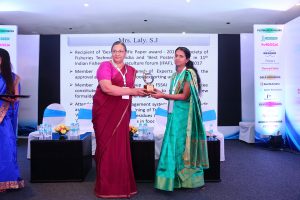 In late February, AOAC’s India Section held their 7th Annual conference on building capacity and collaborative leadership to ensure safe and nutritious food.
In late February, AOAC’s India Section held their 7th Annual conference on building capacity and collaborative leadership to ensure safe and nutritious food.
More than 300 leading specialists from across India and from the United States, Germany, the Netherlands, Singapore, and the United Kingdom participated. An exhibition by eleven global instrument companies on novel technologies and trends in analytical instrumentations were also part of this event. AOAC INTERNATIONAL’s Chief Science Office, Dr. Palmer Orlandi, presented and participated in what he described as an extraordinary event.
“The conference program covered an impressive range of topics and demonstrated that the India Section is advancing quickly to identify issues and find solutions to food safety challenges in this important part of the world,” said Orlandi. “I was once again struck by how true it is that the Sections are AOAC’s ‘eyes and ears on the ground.’”
The conference started with four technical sessions, the first chaired by Orlandi. He highlighted the importance of method harmonization and the need for developing a rapid analysis method for antibiotic residues in food, especially in those commodities important to India. This was followed by a session chaired by Dr. Kaushik Banerjee, Chairman of AOAC India Section, discussing pesticide residues revolving around various approaches to overcome challenges in analyzing difficult pesticide residues. In the next session, the session chair, Dr Bhaskar, who is an Advisor to the Food Safety and Standards Authority of India (FSSAI), highlighted the importance of developing discerning analytical methods to test for food authenticity, and detect non-compliant products. The last session, chaired by Dr. Lalitha Gowda, former Chief-Scientist, CSIR-CFTRI, focused on food nutrition/QC/fortifications. The findings of single lab verification for AOAC Official Method 2015.06 Minerals and Trace Elements in Indian Infant Formula, Adult & Pediatric Nutritional was presented in this session.
Day Two began with a technical session on mycotoxins. Chaired by Dr Alok Srivastava, Chief Scientist, CSIR-CFTRI Mysore, this session focused on some recent developments and new techniques. The next session was chaired by Dr Amit Chandra, Head of Chemistry, Forensic Investigations and Microbiology in the Innovations and Sciences Division of Amway Corporation. This session focused on the impact of specifications on botanical quality/adulteration, and a panel discussed the challenges and opportunities confronting the botanical dietary supplement industry. Dr. J.L.N Sastry, Chief Executive Officer of the Indian National Medicinal Plants Board, highlighted the need to ensure that the scientific base of the industry is kept at pace with the rapid expansion of the manufacturing and marketing components. The last technical session, chaired by Mr. Vishal Arora, Secretary of AOAC India Section, focused on a variety of topics such as challenges in detection of microbial contaminants in drinking water, laboratory planning and design for food and pharma microbiological testing and rapid microbiological methods.
Parallel sessions also took place on both days. On Day One, a joint session including AOAC, the FSSAI and the Netherlands Food and Consumer Product Safety Authority focused on food safety standards and methods and deliberated on the importance of consuming sufficient safe fruits and vegetables and opportunities for doubling farmers’ incomes and agricultural exports. On Day Two the parallel sessions revolved around method validation, the role of public standards in protecting supply chain integrity, introduction to food industry operations and the role of the analytical function and good laboratory practices.
Three new opportunities were identified for potential future action. The first, a method extension pilot for veterinary drug residues in Indian milk products, is aimed at addressing the need for a multiresidue method for regulated antibiotics ; the availability of certain CRMs for antimicrobial residues; and the need for a rapid kit or method for field testing, for example in milk collection centers and production areas.
Another issue identified was the need to encourage the food industry to contribute more research and development towards development or extension of need-based methods. While well established at the AOAC INTERNATIONAL level, in India this process is in its early stage.
Lastly, there was a renewed interest among stakeholders in the region for the expansion of AOAC INTERNATIONAL’s Laboratory Proficiency Testing Program into India.
 Several awards were also part of the program. K. P. Prathish, Ph.D. of the Indian National Institute for Interdisciplinary Science & Technology (NIIST), received the 2020 “Young Scientist Award” recognizing his contribution to analytical chemistry including 18 international journal publications, one patent, and leading work on dioxin and furan analysis in environmental and food samples, among other accomplishments. The “Special Jury Award” went to Nivedita Bhattacharya, Ph.D., currently a post-doctoral Associate at Boston University School of Medicine. She is a mass spectrometry specialist who has one US patent and five international publications. As part of an initiative to support an advanced women doctoral candidate, the Section also presented a 2020 “Women in Analytical Sciences” award. It went to Mrs. Laly. S.J., Quality Assurance Scientist at ICAR Central Institute of Fisheries Technology. She has done work on screening and characterization of allergens in selected shrimp species and its stability under different processing conditions and has twelve publications in Indian and international journals.
Several awards were also part of the program. K. P. Prathish, Ph.D. of the Indian National Institute for Interdisciplinary Science & Technology (NIIST), received the 2020 “Young Scientist Award” recognizing his contribution to analytical chemistry including 18 international journal publications, one patent, and leading work on dioxin and furan analysis in environmental and food samples, among other accomplishments. The “Special Jury Award” went to Nivedita Bhattacharya, Ph.D., currently a post-doctoral Associate at Boston University School of Medicine. She is a mass spectrometry specialist who has one US patent and five international publications. As part of an initiative to support an advanced women doctoral candidate, the Section also presented a 2020 “Women in Analytical Sciences” award. It went to Mrs. Laly. S.J., Quality Assurance Scientist at ICAR Central Institute of Fisheries Technology. She has done work on screening and characterization of allergens in selected shrimp species and its stability under different processing conditions and has twelve publications in Indian and international journals.
The meeting concluded with a “roadmap to the future” discussion that highlighted ideas such as AOAC India Section supporting analytical capacity building in neighboring countries like Sri Lanka, Bangladesh and Bhutan. While considerably more thinking will be required to bring this initiative to reality, a successful program would potentially bring broad method harmonization which would greatly facilitate trade.